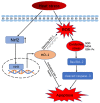HO-1 reduces heat stress-induced apoptosis in bovine granulosa cells by suppressing oxidative stress
- PMID: 31404912
- PMCID: PMC6710052
- DOI: 10.18632/aging.102136
HO-1 reduces heat stress-induced apoptosis in bovine granulosa cells by suppressing oxidative stress
Abstract
Heat stress negatively affects reproduction in cattle by disrupting the normal function of ovarian granulosa cells (GCs), ultimately leading to oxidative damage and cell death via apoptosis. Heme oxygenase-1(HO-1) is a member of the heat shock protein family, which are associated with cellular antioxidant defenses and anti-apoptotic functions. Recent studies demonstrated that HO-1 is upregulated in heat-stressed cells. In the present study, we investigated the expression of HO-1 in bovine GCs transiently exposed to heat stress and characterized the expression and activity of key oxidative stress enzymes and molecules. We show that heat stress induced oxidative stress and apoptosis, and enhanced Nrf2 and HO-1 expression in primary GC cultures. Knocking down HO-1 expression using siRNA exacerbated both oxidative stress and apoptosis, whereas pre-treating GCs with hemin, which induces HO-1 expression, partially prevented these effects. These findings demonstrate that HO-1 attenuates heat stress-induced apoptosis in bovine GCs by decreasing production of reactive oxygen species and activating the antioxidant response.
Keywords: HO-1; apoptosis; granulosa cells; heat stress; reactive oxygen species (ROS).
Conflict of interest statement
Figures






Similar articles
-
Oxidative and endoplasmic reticulum stress defense mechanisms of bovine granulosa cells exposed to heat stress.Theriogenology. 2018 Apr 1;110:130-141. doi: 10.1016/j.theriogenology.2017.12.042. Epub 2018 Jan 17. Theriogenology. 2018. PMID: 29396041
-
Heme oxygenase 1 regulates apoptosis induced by heat stress in bovine ovarian granulosa cells via the ERK1/2 pathway.J Cell Physiol. 2019 Apr;234(4):3961-3972. doi: 10.1002/jcp.27169. Epub 2018 Sep 7. J Cell Physiol. 2019. PMID: 30191981
-
Docosahexaenoic acid (DHA)-induced heme oxygenase-1 attenuates cytotoxic effects of DHA in vascular smooth muscle cells.Atherosclerosis. 2013 Oct;230(2):406-13. doi: 10.1016/j.atherosclerosis.2013.08.002. Epub 2013 Aug 13. Atherosclerosis. 2013. PMID: 24075775
-
Cellular and functional adaptation to thermal stress in ovarian granulosa cells in mammals.J Therm Biol. 2020 Aug;92:102688. doi: 10.1016/j.jtherbio.2020.102688. Epub 2020 Aug 12. J Therm Biol. 2020. PMID: 32888576 Review.
-
Cellular and Molecular Adaptation of Bovine Granulosa Cells and Oocytes under Heat Stress.Animals (Basel). 2020 Jan 9;10(1):110. doi: 10.3390/ani10010110. Animals (Basel). 2020. PMID: 31936655 Free PMC article. Review.
Cited by
-
The effect of carbon monoxide on meiotic maturation of porcine oocytes.PeerJ. 2021 Mar 23;9:e10636. doi: 10.7717/peerj.10636. eCollection 2021. PeerJ. 2021. PMID: 33828903 Free PMC article.
-
Bi-directional regulation of type I interferon signaling by heme oxygenase-1.iScience. 2024 Feb 8;27(3):109185. doi: 10.1016/j.isci.2024.109185. eCollection 2024 Mar 15. iScience. 2024. PMID: 38420586 Free PMC article.
-
Resveratrol Promotes Proliferation, Antioxidant Properties, and Progesterone Production in Yak (Bos grunniens) Granulosa Cells.Animals (Basel). 2024 Jan 12;14(2):240. doi: 10.3390/ani14020240. Animals (Basel). 2024. PMID: 38254409 Free PMC article.
-
The Dynamic Transcription Profiles of Proliferating Bovine Ovarian Granulosa When Exposed to Increased Levels of β-Hydroxybutyric Acid.Front Vet Sci. 2022 Aug 5;9:915956. doi: 10.3389/fvets.2022.915956. eCollection 2022. Front Vet Sci. 2022. PMID: 35990259 Free PMC article.
-
Effect of Exogenous Melatonin on the Development of Mice Ovarian Follicles and Follicular Angiogenesis.Int J Mol Sci. 2021 Oct 19;22(20):11262. doi: 10.3390/ijms222011262. Int J Mol Sci. 2021. PMID: 34681919 Free PMC article.
References
-
- Hansen PJ. Cellular and molecular basis of therapies to ameliorate effects of heat stress on embryonic development in cattle. Anim Reprod. 2013; 10:322–33.
Publication types
MeSH terms
Substances
LinkOut - more resources
Full Text Sources
Medical
Molecular Biology Databases
Miscellaneous

